New Products & Services
October 2025
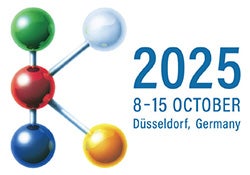 Over 3,200 exhibitors from around the globe will be showing their products and services during K 2025 (Düsseldorf, Germany; October 8–15; www.k-online.com), the world’s largest tradefair for plastics and rubber. This year’s event will feature the K 2025 Start-up Zone — a platform for 20 innovative, new companies to showcase their technologies, which will include novel approaches to artificial intelligence (AI), resource conservation, bioplastics production and more. A small sample of products and services on display during K 2025 is presented below.
Over 3,200 exhibitors from around the globe will be showing their products and services during K 2025 (Düsseldorf, Germany; October 8–15; www.k-online.com), the world’s largest tradefair for plastics and rubber. This year’s event will feature the K 2025 Start-up Zone — a platform for 20 innovative, new companies to showcase their technologies, which will include novel approaches to artificial intelligence (AI), resource conservation, bioplastics production and more. A small sample of products and services on display during K 2025 is presented below.
More sustainable cooling and energy allocation
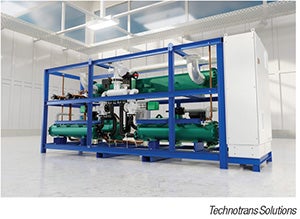 Tightening gas regulations mean that environmentally friendly refrigerant use is an increasingly important consideration for operators. The kws series of chillers (photo) operates with propane (R290), helping users to continue production in a compliant manner over the long term, and to significantly reduce their carbon footprint. In addition to chillers, the ksw series also includes a highly efficient heat pump that enables the active use of waste heat for heating processes. As part of its offerings, the company analyzes the entire energy balance and designs customized system solutions. This may include the integration of free coolers to achieve significant energy savings during cooler months or the use of process waste heat to heat buildings, replacing fossil fuels and further reducing operating costs. Hall 10, Stand H23 — technotrans solutions GmbH, Meinerzhagen, Germany
Tightening gas regulations mean that environmentally friendly refrigerant use is an increasingly important consideration for operators. The kws series of chillers (photo) operates with propane (R290), helping users to continue production in a compliant manner over the long term, and to significantly reduce their carbon footprint. In addition to chillers, the ksw series also includes a highly efficient heat pump that enables the active use of waste heat for heating processes. As part of its offerings, the company analyzes the entire energy balance and designs customized system solutions. This may include the integration of free coolers to achieve significant energy savings during cooler months or the use of process waste heat to heat buildings, replacing fossil fuels and further reducing operating costs. Hall 10, Stand H23 — technotrans solutions GmbH, Meinerzhagen, Germany
High-performance pressing for plastics pelletizing plants
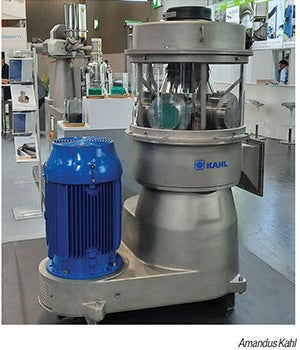 Pressing is a crucial step in any pelletizing plant because pressing can significantly increase bulk density. Compared to the starting material, the compactness of the pellets favors lower transport costs in conjunction with increased storage capacities. In addition, the conversion reduces heavy dust generation, especially in the case of small-structured pellets. The standardization of the material size represents another advantage — the pellets produced all have a predetermined size, so that the conveying systems can be operated reliably. This company offers variable machines and press types that cover different throughput capacities and are individually equipped for different bulk solids and materials. For example, the small press (photo) is particularly suitable for small pellet production from powdery and lumpy products. It offers low-effort installation. Furthermore, the 14-175 press model enables dry granulation before subsequent pressing of the tablet mass. Pellet presses and mills can be specified with GMP certification for use in pharmaceutical applications. Hall 10, Stand B51 — Amandus Kahl GmbH & Co. KG, Reinbek, Germany
Pressing is a crucial step in any pelletizing plant because pressing can significantly increase bulk density. Compared to the starting material, the compactness of the pellets favors lower transport costs in conjunction with increased storage capacities. In addition, the conversion reduces heavy dust generation, especially in the case of small-structured pellets. The standardization of the material size represents another advantage — the pellets produced all have a predetermined size, so that the conveying systems can be operated reliably. This company offers variable machines and press types that cover different throughput capacities and are individually equipped for different bulk solids and materials. For example, the small press (photo) is particularly suitable for small pellet production from powdery and lumpy products. It offers low-effort installation. Furthermore, the 14-175 press model enables dry granulation before subsequent pressing of the tablet mass. Pellet presses and mills can be specified with GMP certification for use in pharmaceutical applications. Hall 10, Stand B51 — Amandus Kahl GmbH & Co. KG, Reinbek, Germany
Advanced mixing and agitation for polymerization reactions
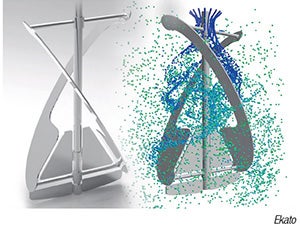 Varioblade (photo) is a highly flexible impeller developed specifically for reactors used in the production of polymers and elastomers. Thanks to its variable geometry, the Varioblade can be optimally adapted to different process requirements. Its modular design allows for easy integration into existing systems and offers maximum flexibility for product changes and process optimization. For highly demanding polymerization processes, this company also offers the HWL-N type reactor agitator, which features drive capacities of up to 4,000 kW, and is specifically designed for processing highly viscous media and complex reaction conditions. Hall 11, Stand A67 — EKATO Rühr- und Mischtechnik GmbH, Schopfheim, Germany
Varioblade (photo) is a highly flexible impeller developed specifically for reactors used in the production of polymers and elastomers. Thanks to its variable geometry, the Varioblade can be optimally adapted to different process requirements. Its modular design allows for easy integration into existing systems and offers maximum flexibility for product changes and process optimization. For highly demanding polymerization processes, this company also offers the HWL-N type reactor agitator, which features drive capacities of up to 4,000 kW, and is specifically designed for processing highly viscous media and complex reaction conditions. Hall 11, Stand A67 — EKATO Rühr- und Mischtechnik GmbH, Schopfheim, Germany
A multi-source platform for holistic heat recovery
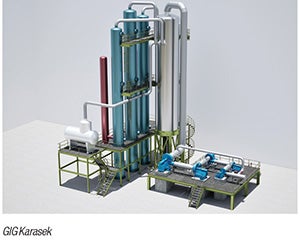 VarioVAP (photo) presents a holistic multi-source solution for industrial waste-heat recovery. With VarioVAP, a wide variety of waste-heat streams can be centrally consolidated and converted into valuable fresh steam — even those previously considered uneconomical for recovery. Notably, differences in temperature, pressure or energy levels do not present obstacles to the system’s operation. This enables the full integration of diverse heat sources. The heart of the VarioVAP system consists of a plate falling-film evaporator, serving as a highly efficient heat exchanger. Each heat source, whether steam or liquid, is fed in separately, processed and converted into a joint stream of fresh steam that can then be flexibly used for production processes or external applications. The plate falling-film evaporator can operate either as a standalone heat exchanger or in combination with mechanical vapor recompression (MVR). In the latter configuration, the generated fresh steam is additionally raised to a higher energy level. Hall 12, Stand F35-02 — Gig Karasek GmbH, Gloggnitz, Austria
VarioVAP (photo) presents a holistic multi-source solution for industrial waste-heat recovery. With VarioVAP, a wide variety of waste-heat streams can be centrally consolidated and converted into valuable fresh steam — even those previously considered uneconomical for recovery. Notably, differences in temperature, pressure or energy levels do not present obstacles to the system’s operation. This enables the full integration of diverse heat sources. The heart of the VarioVAP system consists of a plate falling-film evaporator, serving as a highly efficient heat exchanger. Each heat source, whether steam or liquid, is fed in separately, processed and converted into a joint stream of fresh steam that can then be flexibly used for production processes or external applications. The plate falling-film evaporator can operate either as a standalone heat exchanger or in combination with mechanical vapor recompression (MVR). In the latter configuration, the generated fresh steam is additionally raised to a higher energy level. Hall 12, Stand F35-02 — Gig Karasek GmbH, Gloggnitz, Austria
Devolatize sensitive products with these efficient systems
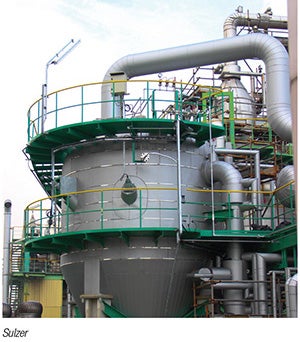 This company offers a wide range of energy-efficient processing technologies, including mixers, reactors and heat exchangers, that address the most critical challenges in polymer processing. These include thermal management in polymerization, advanced devolatilization and precision melt blending, each designed to optimize production while reducing environmental impact. In particular, DEVO devolatilization systems (photo) achieve over 99.9% polymer purity with low shear and a modular design. This makes them particularly well-suited for sensitive applications, such as food packaging, healthcare and biopolymers, where product safety and regulatory compliance are essential. Hall 12, Stand B70 — Sulzer Chemtech AG, Winterthur, Switzerland
This company offers a wide range of energy-efficient processing technologies, including mixers, reactors and heat exchangers, that address the most critical challenges in polymer processing. These include thermal management in polymerization, advanced devolatilization and precision melt blending, each designed to optimize production while reducing environmental impact. In particular, DEVO devolatilization systems (photo) achieve over 99.9% polymer purity with low shear and a modular design. This makes them particularly well-suited for sensitive applications, such as food packaging, healthcare and biopolymers, where product safety and regulatory compliance are essential. Hall 12, Stand B70 — Sulzer Chemtech AG, Winterthur, Switzerland
This product family features a wide range of pelletizing options
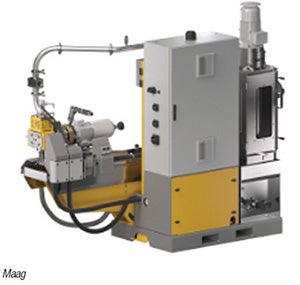 The new Pearlo CS (photo) is a compact pelletizing system with underwater capabilities that features the established Pearlo tangential cutting chamber and optimized cutter design. Offered in two sizes, it targets production scales where flexibility and efficiency are essential. According to the manufacturer, Pearlo CS was designed specifically for manufacturers who need excellent performance in a streamlined footprint. The Pearlo family also includes the Pearlo 350 pelletizer — the largest underwater pelletizing system for polyethylene terephthalate (PET) production — which now features a new plate design that helps ensure long tool life, precise cutting and reduced fines. For high throughputs, the central injection system (CIS) die plate introduces water centrally through the die plate to reduce agglomerates and improve pellet cooling. Hall 9, Stand A02 — Maag Pump Systems AG, Oberglatt, Switzerland
The new Pearlo CS (photo) is a compact pelletizing system with underwater capabilities that features the established Pearlo tangential cutting chamber and optimized cutter design. Offered in two sizes, it targets production scales where flexibility and efficiency are essential. According to the manufacturer, Pearlo CS was designed specifically for manufacturers who need excellent performance in a streamlined footprint. The Pearlo family also includes the Pearlo 350 pelletizer — the largest underwater pelletizing system for polyethylene terephthalate (PET) production — which now features a new plate design that helps ensure long tool life, precise cutting and reduced fines. For high throughputs, the central injection system (CIS) die plate introduces water centrally through the die plate to reduce agglomerates and improve pellet cooling. Hall 9, Stand A02 — Maag Pump Systems AG, Oberglatt, Switzerland
New frontiers in circular materials and processes
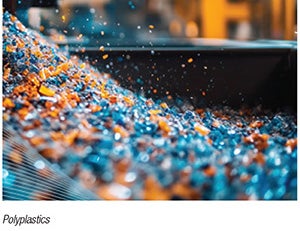 This company’s Duracircle family of circular-economy platform technologies is expanding with the future addition of several groundbreaking technologies related to plastics processing (photo): a chemical recycling technology for polyoxymethylene (POM; also known as acetal, polyacetal, and polyformaldehyde); and a solvent-based recycling process for polybutylene terephthalate (PBT) that can segregate glass-reinforced polycarbonate/PBT into its constituents. The company is also focusing development work on bio-based p-hydroxybenzoic acid (PHBA), which is a key monomer for liquid crystal polymer (LCP), and an artificial-intelligence-aided mechanical recycling technology. Hall 7a, Stand B02 — Polyplastics Europe GmbH, Raunheim, Germany
This company’s Duracircle family of circular-economy platform technologies is expanding with the future addition of several groundbreaking technologies related to plastics processing (photo): a chemical recycling technology for polyoxymethylene (POM; also known as acetal, polyacetal, and polyformaldehyde); and a solvent-based recycling process for polybutylene terephthalate (PBT) that can segregate glass-reinforced polycarbonate/PBT into its constituents. The company is also focusing development work on bio-based p-hydroxybenzoic acid (PHBA), which is a key monomer for liquid crystal polymer (LCP), and an artificial-intelligence-aided mechanical recycling technology. Hall 7a, Stand B02 — Polyplastics Europe GmbH, Raunheim, Germany
A novel laminate material for flexible sensor electronics
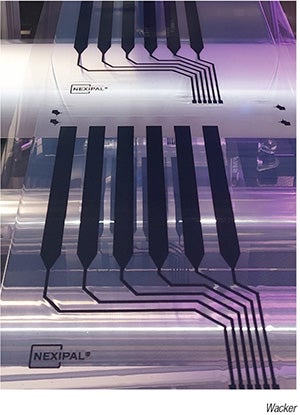 Nexipal Sense laminates (photo) consist of highly stretchable insulating and electrically conductive silicone rubber films. The laminate, a stack of film layers, jointly works as a flexible and stretchable capacitor. Pressure or flex movements change the electrical capacitance of the component. Different capacity states thus provide precise sensor signals for applications in medical technology, robotics and sports, and sets new standards for the development and application of flexible electronics. The silicone laminates typically consist of layers each with a film thickness of between 20 to 200 microns. The addition-curing silicone rubber laminates are characterized by their exceptional elasticity, dimensional stability and toughness. They are skin-friendly, biocompatible, UV-resistant and can withstand temperatures from –40 to 180°C. Even after millions of load cycles, they retain their high degree of recovery and elasticity, providing a major advantage over conventional materials. The structured layers — consisting of specially developed electrically conductive silicones — are composed using digital laser-printing techniques. With a resulting pixel size of just 100 microns, very fine electrode geometries are possible. Hall 6, Stand A10 — Wacker Chemie AG, Munich, Germany
Nexipal Sense laminates (photo) consist of highly stretchable insulating and electrically conductive silicone rubber films. The laminate, a stack of film layers, jointly works as a flexible and stretchable capacitor. Pressure or flex movements change the electrical capacitance of the component. Different capacity states thus provide precise sensor signals for applications in medical technology, robotics and sports, and sets new standards for the development and application of flexible electronics. The silicone laminates typically consist of layers each with a film thickness of between 20 to 200 microns. The addition-curing silicone rubber laminates are characterized by their exceptional elasticity, dimensional stability and toughness. They are skin-friendly, biocompatible, UV-resistant and can withstand temperatures from –40 to 180°C. Even after millions of load cycles, they retain their high degree of recovery and elasticity, providing a major advantage over conventional materials. The structured layers — consisting of specially developed electrically conductive silicones — are composed using digital laser-printing techniques. With a resulting pixel size of just 100 microns, very fine electrode geometries are possible. Hall 6, Stand A10 — Wacker Chemie AG, Munich, Germany
Combined extruding and degassing for plastics recycling
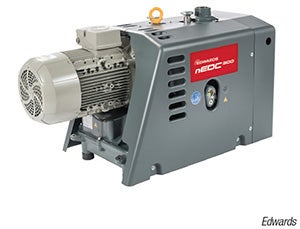 The EXDM dry-running extruder degassing system has been specially developed for plastics processing and recycling. The modular package is based on the robust EDC dry-claw vacuum pump (photo), which is equally suitable for integration into new and existing systems. The EXDM vacuum solution offers users a reliable system with low operating and service costs. To ensure that EXDM runs efficiently and reliably on site, the manufacturer offers users a wide range of specifically tailored service solutions. These capabilities range from the initial on-site consultation to the design of a suitable vacuum system and customized maintenance contracts, which helps ensure lower operating costs throughout the equipment lifecycle. Hall 11, Stand I31— Edwards GmbH, Feldkirchen, Germany
The EXDM dry-running extruder degassing system has been specially developed for plastics processing and recycling. The modular package is based on the robust EDC dry-claw vacuum pump (photo), which is equally suitable for integration into new and existing systems. The EXDM vacuum solution offers users a reliable system with low operating and service costs. To ensure that EXDM runs efficiently and reliably on site, the manufacturer offers users a wide range of specifically tailored service solutions. These capabilities range from the initial on-site consultation to the design of a suitable vacuum system and customized maintenance contracts, which helps ensure lower operating costs throughout the equipment lifecycle. Hall 11, Stand I31— Edwards GmbH, Feldkirchen, Germany
Materials science innovations to address global megatrends
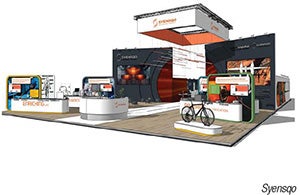 In its stand at K Show (photo), this company will showcase materials-science solutions addressing industry megatrends, including materials for electrification, compressors, healthcare devices, semiconductors, hydrogen production and more. Live demonstrations and presentations will cover a variety of topics, including: replacing metal with high-performance polymers in e-compressor housings; how AI is redefining materials science; specialty polymers for single-use surgical instruments; and more. Hall 6, Stand C61 — Syensqo S.A., Brussels, Belgium
In its stand at K Show (photo), this company will showcase materials-science solutions addressing industry megatrends, including materials for electrification, compressors, healthcare devices, semiconductors, hydrogen production and more. Live demonstrations and presentations will cover a variety of topics, including: replacing metal with high-performance polymers in e-compressor housings; how AI is redefining materials science; specialty polymers for single-use surgical instruments; and more. Hall 6, Stand C61 — Syensqo S.A., Brussels, Belgium
Solutions to deoderize and homogenize recycled materials
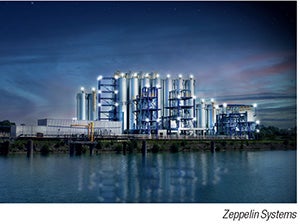 This company offers solutions for almost the entire process chain of plastics recycling plants (photo) from storage and conveying to the agglomeration and compaction of fluffy materials to compounding and deodorization. Especially for light fractions, such as films, fleeces or fibers, the Fluff-TEC solution ensures a homogeneous flow mass that can be processed efficiently and at the same time reduces the storage volume. Another key process in plastics recycling step is deodorization. The Fresh-TEC solution uses air flushing to remove volatile organic compounds from the recycled materials. This means that high-quality recyclates can be reused even in sensitive applications and certified according to FDA and EFSA. Hall 10, Stand C14 — Zeppelin Systems GmbH, Friedrichshafen, Germany
This company offers solutions for almost the entire process chain of plastics recycling plants (photo) from storage and conveying to the agglomeration and compaction of fluffy materials to compounding and deodorization. Especially for light fractions, such as films, fleeces or fibers, the Fluff-TEC solution ensures a homogeneous flow mass that can be processed efficiently and at the same time reduces the storage volume. Another key process in plastics recycling step is deodorization. The Fresh-TEC solution uses air flushing to remove volatile organic compounds from the recycled materials. This means that high-quality recyclates can be reused even in sensitive applications and certified according to FDA and EFSA. Hall 10, Stand C14 — Zeppelin Systems GmbH, Friedrichshafen, Germany
Bio-based wax additives for lubricants, dispersants and more
Rice bran wax is a natural and sustainable alternative to other waxes, including montan and synthetic waxes, providing users with sustainable options while maintaining the desired product characteristics. This company’s bio-based range of additives, Licocare RBW Vita, supports this development and delivers on both performance and sustainability. The Licocare RBW Vita range offers a reduction of up to 70% in product carbon footprint (PCF) compared to traditional fossil-based montan waxes, providing an alternative with a significantly lower environmental impact. Hall 8a, Stand J11 — Clariant AG, Muttenz, Switzerland